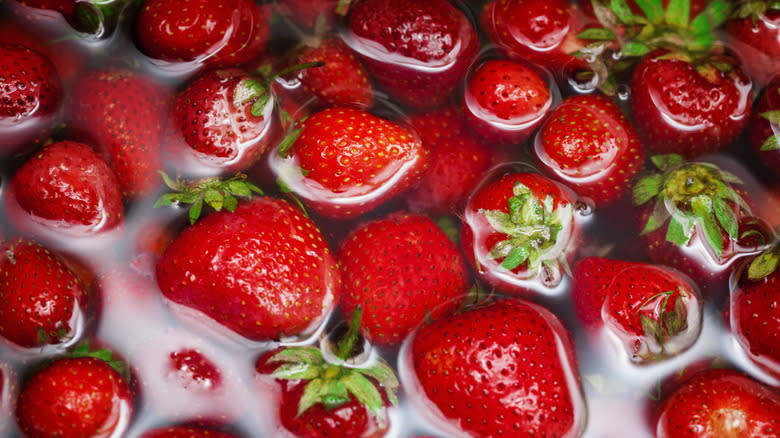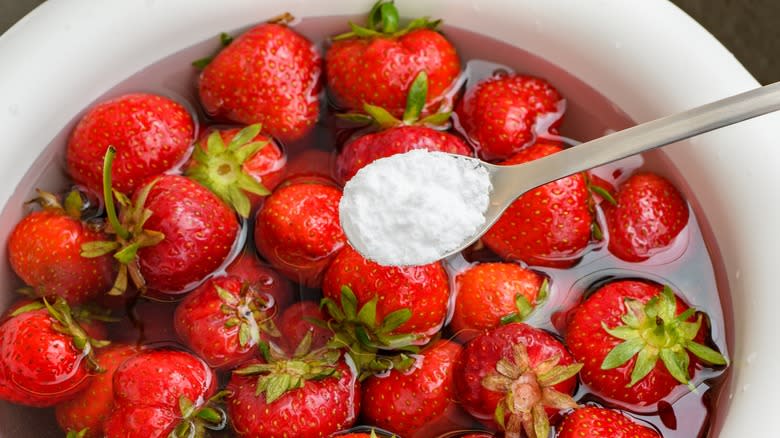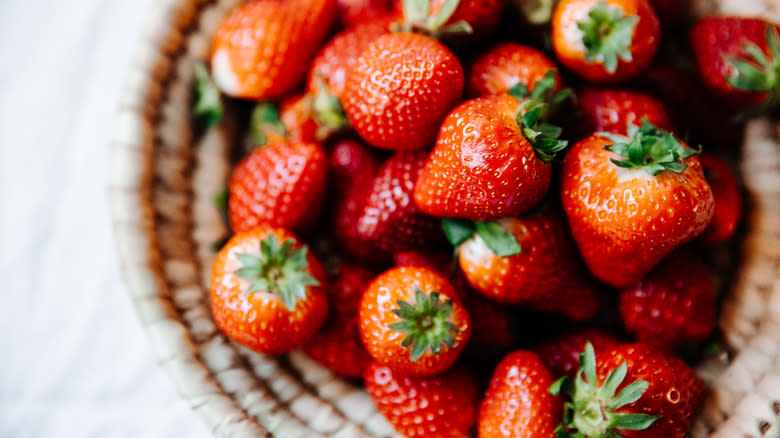The Best Method For Cleaning Strawberries Is Soaking, Not Rinsing

There is nothing quite like the taste of fresh strawberries. The sweet, luscious, and slightly tart flavor offers a feeling of summer, even if you're eating them in the dead of winter. They're the perfect filling for bright, fresh pies or tarts, an ideal jam for toast or scones, a garnish for salads or drinks, an accompaniment to cream — strawberries are a versatile fruit. If you get them during the peak of their season, though, there's nothing better than snacking on strawberries alone.
When you've just made a trip to the grocery store or the market and that strong strawberry scent hits you from deep inside your shopping bags, it can be tempting to just reach over and start noshing. But getting the fruit clean is the first step of the process (and not just strawberries — that goes for any fruit). According to the Centers for Disease Control and Prevention, raw fruits can contain harmful germs, like Salmonella, E. coli, and Listeria. They can also have dirt, pesticides, and tiny bugs on their surface, so a good wash is crucial before eating. Rinsing strawberries under running water is a common way to get them clean, but for the deepest clean that'll wash away those things you don't want to ingest, you're going to want to give them a good soak.
Read more: 12 Vegetables And Fruits That Used To Look Very Different
Reap The Fruits Of Your Labor

You won't have to soak the strawberries for long, but the soak time does vary, depending on what you're adding to the water. Some soaks need as little as 30 seconds, while others will require as much as 20 minutes. A soak of hot water alone typically only needs a short period of around 30 seconds, and it can help extend the shelf life of the strawberries. For a deeper clean, though, you can enhance the soak by adding ingredients like salt, baking soda, or vinegar to warm water.
The coarse, abrasive quality of salt is a great way to remove dirt, pesticides, and bugs, and once you rinse the salt water off after a five-minute soak, the flavor and texture of your strawberries will stay the same. You can also use a little bit of white distilled vinegar mixed in the warm water for the same sanitizing effects; just soak the strawberries for around 20 minutes and rinse them thoroughly to avoid any lingering vinegar taste. These methods will also help the fruit last a little longer so that you can keep enjoying your strawberries throughout the week.
Baking soda is another frequently recommended additive for a strawberry soak, but it has its downsides. Baking soda can permeate the fruit and make the strawberries softer instead of maintaining their firm texture. Although it can still help sanitize, it isn't always the best flavor and texture choice.
Cleanliness Considerations And Storage Tips

The strawberry soak is crucial to get the fruit as clean as it can be, but there are a few other rules to follow for the best quality -- starting with buying the freshest strawberries. While it's easier to wash the whole batch at once, it's important to wait to wash the strawberries until you plan to eat or use them. The added moisture of a soak could make the strawberries go bad more quickly than they would unwashed -- with the exception of a hot water soak which can make them last longer. Just be sure to dry the strawberries thoroughly with a paper towel or kitchen towel to remove some of that post-soak moisture.
Speaking of moisture, its avoidance also plays a part in how you store strawberries and you may be making a mistake while storing the fruit. Keeping whole strawberries in an airtight container will cause them to go bad more quickly, since the container traps moisture inside. Instead, use a colander or other open container — or you can refrigerate them on a paper towel-lined pan. If you're storing your strawberries already cut or sliced, then the airtight container will be your friend; exposed to air, the cut strawberries can start to dry out and attract bacteria.
Read the original article on Daily Meal.

